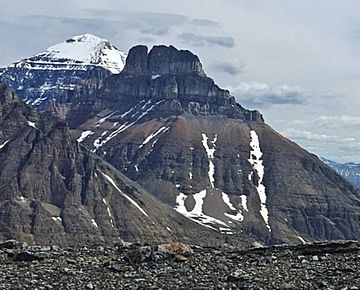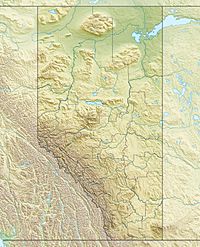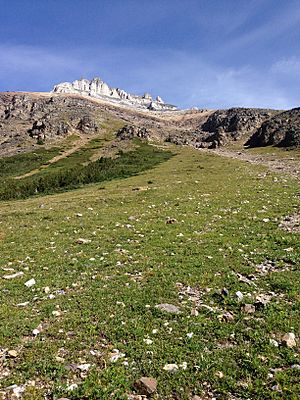Eiffel Peak facts for kids
Quick facts for kids Eiffel Peak |
|
|---|---|

Eiffel Peak (center) with snow-capped Mount Temple (left) seen from Wenkchemna Pass
|
|
| Highest point | |
| Elevation | 3,077 m (10,095 ft) |
| Prominence | 465 m (1,526 ft) |
| Listing | Mountains of Alberta |
| Geography | |
| Location | Alberta |
| Parent range | Bow Range Canadian Rockies |
| Topo map | NTS 82N/08 |
| Type of rock | Sedimentary rock |
| Climbing | |
| First ascent | 1901 Charles S. Thompson, G.M. Weed, H. Kaufmann |
| Easiest route | Scramble |
Eiffel Peak is a tall mountain in Banff National Park in Alberta, Canada. It stands about 3,077 meters (10,095 feet) high. This peak is part of the Bow Range, which is a smaller group of mountains within the huge Canadian Rockies. The closest taller mountain is Mount Temple, located about 3 kilometers (1.9 miles) to the northeast.
Contents
History of Eiffel Peak
First Climbers
The first time anyone climbed to the very top of Eiffel Peak was in 1901. Two climbers, Charles S. Thompson and G.M. Weed, made this first successful climb. They had a guide named Hans Kaufmann who helped them find their way safely.
How the Peak Got Its Name
The mountain was given its name in 1908 by Arthur O. Wheeler. He was a famous surveyor and mountaineer. Wheeler named it "Eiffel Peak" because it was so tall, just like the famous Eiffel Tower in Paris, France. The name became official in 1952, approved by the Geographical Names Board of Canada.
Geology of the Mountain
What Rocks Make Up Eiffel Peak?
Eiffel Peak is made of a type of rock called sedimentary rock. This kind of rock forms over a very long time from layers of sand, mud, and tiny bits of sea creatures that settle at the bottom of ancient seas.
How the Rocks Were Formed
The sedimentary rocks of Eiffel Peak were laid down during the Precambrian and Jurassic periods. These are huge spans of time in Earth's history, going back hundreds of millions of years. Imagine shallow seas covering this area long ago, where these layers slowly built up. Later, during an event called the Laramide orogeny, these rock layers were pushed up and folded. This powerful process created the mountains we see today, including Eiffel Peak.
Climate Around Eiffel Peak
Weather in the Mountains
Eiffel Peak is located in a subarctic climate zone. This means it has very cold and snowy winters. The summers are usually mild, not too hot.
Winter Temperatures
During the winter, temperatures can drop below −20 degrees Celsius (−4 degrees Fahrenheit). When you add the wind chill factor, it can feel even colder, sometimes below −30 degrees Celsius (−22 degrees Fahrenheit). This climate is typical for high mountains in places like the Canadian Rockies.




